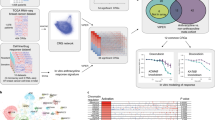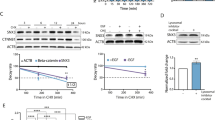Abstract
Breast cancers are either primarily resistant to chemotherapy (intrinsic resistance), or respond to chemotherapy but later recur with a multidrug-resistant phenotype because of overexpression of the multidrug transporter P-glycoprotein1. The MDR1 gene encoding P-glycoprotein may be transcriptionaily regulated by a Y-box transcription factor2. We now report that, in multidrug-resistant MCF-7 breast cancer cells, nuclear localization of YB-1 is associated with MDR-1 gene expression. In drug-sensitive MCF-7 cells, however, YB-1 was localized to the cytoplasm. Regulated overexpression of YB-1 in drug-sensitive diploid breast epithelial cells induced MDR-1 gene expression and multidrug resistance. In 27 out of 27 untreated primary breast cancers, YB-1 protein was expressed in the cytoplasm although it was undetectable in normal breast tissue of these patients. In a subgroup of tumors (9/27), however, YB-1 was also localized to the nucleus and, in these cases, high levels of P-glycoprotein were present. These results show that in a subset of untreated primary breast cancers, nuclear localization of YB-1 protein is associated with intrinsic multidrug resistance. Our data show that YB-1 has an important role in controlling MDR1 gene transcription and this finding provides a basis for the analysis of molecular mechanisms responsible for intrinsic multidrug resistance in human breast cancer.
This is a preview of subscription content, access via your institution
Access options
Subscribe to this journal
Receive 12 print issues and online access
$209.00 per year
only $17.42 per issue
Buy this article
- Purchase on Springer Link
- Instant access to full article PDF
Prices may be subject to local taxes which are calculated during checkout
Similar content being viewed by others
References
Gottesman, M.M. & Pastan, I. Biochemistry of multidrug resistance mediated by the multidrug transporter. Annu. Rev. Biochem. 62, 385–427 (1993).
Goldsmith, M.E., Madden, M.J., Morrow, C.S. & Cowan, K.H. A Y-box consensus sequence is required for basal expression of the human multidrug resistance (MDR1) gene. J. Biol. Chem. 268, 5856–5860 (1993).
Verelle, P. et al. Clinical relevance of immunohistochemical detection of multidrug resistance P-glycoprotein in breast carcinoma. J. Natl. Cancer Inst. 83, 111–116 (1991).
Schneider, J. et al. P-glycoprotein, HER-2/neu and mutant p53 expression in human gynecologic tumors. J. Natl. Cancer Inst. 86, 850–855 (1994).
Madden, M.J. et al. Identification of 5′ and 3′ sequences involved in the regulation of transcription of the human MDR1 gene in vivo. J. Biol. Chem. 268, 8209–8297 (1993).
van Groeningen, M., Valentijn, L.J. & Baas, F. Identification of a functional initiator sequence in the human MDR1 promoter. Biochim. Biophys. Acta 1172, 138–146 (1993).
Wolffe, A.P. Structural and functional properties of the evolutionary ancient Y-box family of nucleic acid binding proteins. BioEssays 16, 245–251 (1994).
Ladomery, M. & Sommerville, J. A role for Y-box proteins in cell proliferation. BioEssays 17, 9–11 (1995).
Asakuno, K. et al. Involvement of a DNA binding protein, MDR-NFY/YB-1, in human MDR1 gene expression by actinomycin D. Bochem. Biophys. Res. Commun. 199, 1428–1435 (1994)
Gossen, M. & Bujard, H. Tight control of gene expression in mammalian cells by tetracycline responsive promoters. Proc. Natl. Acad. Sci. USA 89, 5547–5551 (1992)
Bittl, A., Nap, M., Jäger, W., Cornillie, F. & Lang, N. Immunohistochemical detection of P-glycoprotein on frozen and paraffin-embedded tissue sections of normal and malignant tissues. Anticancer Res. 15, 1007–1014 (1995).
Sanfilippo, O., Ronchi, E., De-Marco, C., Di-Fronzo, G. & Silvestrini, R. Expression of P-glycoprotein in breast cancer tissue and in vitro resistance to doxorubicin and vincristine. Eur J. Cancer 27, 155–158 (1991).
Pinedo, H.M. & Giaccone, G., P-glycoprotein — a marker of cancer-cell behavior. New Engl. J. Med. 333, 1417–1419 (1995).
Lee, C.H., Bradley, G. & Ling, V. Expression of P-glycoprotein in normal and malignant rat liver cells. Cold Spring Harbor Symp. Quant. Biol. 59, 607–615 (1994).
Weinstein, R.S. et al. Relationship of the expression of the multidrug resistance gene product (P-glycoprotein) in human colon carcinoma to local tumor aggressiveness and lymph node metastasis. Cancer Res. 51, 2720–2726 (1991).
Baldini, N. et al. Expression of P-glycoprotein in high-grade osteosarcomas in relation to clinical outcome. New Engl. J. Med. 333, 1380–1385 (1995).
Spitkovsky, D.D. et al. Tissue restricted expression and chromosomal localization of the YB-1 gene encoding a 42kD nuclear CCAAT binding protein. Nucleic Acids Res. 20, 797–803 (1992).
Bargou, R.C. et al. Overexpression of the death-promoting gene bax-alpha which is downregulated in breast cancer restores sensitivity to different apoptotic stimuli and reduces tumor growth in SCID mice. J. Clin. Invest. 97, 2651–2659 (1996).
Grinstein, E., Weinert, I., Pagano, M., Droese, B. & Royer, H.-D. Cell cycle regulation of nuclear factor p92 DNA-binding activity by novel phase-specific inhibitors. J. Biol. Chem. 271, 9215–9222 (1996).
Royer, H.-D. et al. Delineation of human papillomavirus type 18 enhancer binding proteins: The intra cellular distribution of a novel octamer binding protein p92 is Cell cycle regulated. Nucleic Acids Res. 19, 2363–2371 (1991).
Author information
Authors and Affiliations
Rights and permissions
About this article
Cite this article
Bargou, R., Jürchott, K., Wagener, C. et al. Nuclear localization and increased levels of transcription factor YB-1 in primary human breast cancers are associated with intrinsic MDR1 gene expression. Nat Med 3, 447–450 (1997). https://doi.org/10.1038/nm0497-447
Received:
Accepted:
Issue Date:
DOI: https://doi.org/10.1038/nm0497-447
This article is cited by
-
YBX1/lncRNA SBF2-AS1 interaction regulates proliferation and tamoxifen sensitivity via PI3K/AKT/MTOR signaling in breast cancer cells
Molecular Biology Reports (2023)
-
Holistic anti-tumor resistance mechanism of YBX1 and its potential as a chemoresistance target in pancreatic ductal adenocarcinoma
Holistic Integrative Oncology (2023)
-
Long non-coding RNAs involved in different steps of cancer metastasis
Clinical and Translational Oncology (2022)
-
Pleiotropic roles of cold shock proteins with special emphasis on unexplored cold shock protein member of Plasmodium falciparum
Malaria Journal (2020)
-
BRD7 suppresses invasion and metastasis in breast cancer by negatively regulating YB1-induced epithelial-mesenchymal transition
Journal of Experimental & Clinical Cancer Research (2020)



